Museums Doge's Palace | Guggenheim | Correr | Pesaro | Rezzonico | Murano | Accademia | Oriental | Ca d'Oro | Archeological | Querini | Bovolo | Pisani | Fortuny | Rocco | Lace | Marciana | Grassi | Dogana
San Rocco History Art | Location | Opening Hours Tickets | Authorizations
History Art Scuola | Rivalries | Crucifixion | Pilate Ecce Homo Calvary | Official Painter | Snake | Moses Manna | Sin Isaac Jacob | Adoration Temptation Breads | Probatic Pool Last Supper | Olive Garden Resurrection | Pianta | Annunciation Adoration Flight | Innocents Circumcision
Scuola Grande San Rocco Venice “The Original Sin” by Tintoretto
The Tintoretto “The Original Sin”
Oil on Canvas (265 x 370 cm) 1577-1578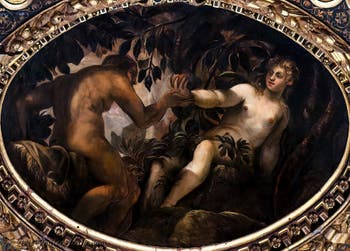
Original Sin The Yahwist account of Genesis (chapter 2) tells us:
7 “Yahweh God fashioned man, dust from the ground, and breathed into his nostrils the breath of life, and man became a living being.”
8 “Yahweh God planted the garden in Eden, in the east, and there he put the man whom he had fashioned.”
But God places a restriction on this power and this free enjoyment:
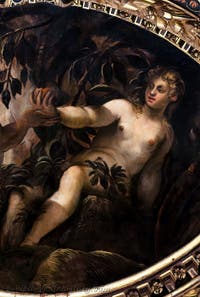
The Original Sin
16 “Of every tree of the garden thou mayest eat, but of the tree of the knowledge of good and evil thou shalt not eat of it; for in the day that thou eatest thereof thou shalt surely die.”
The scene of Original Sin shows us the precise moment when the primordial couple is about to give in to the temptation to transgress the divine prohibition.
Adam and Eve are naked, sitting under a tree; the light illuminates the face and body of Eve who is holding out the forbidden fruit to Adam whose entire left half of the body is already in shadow, and whose attitude seems to convey hesitation and anguish.
The sting of curiosity and the vertigo of anguish are present at the very moment they decide to lose their innocence and defy God.
E t this decision is an act of the will that initiates the fall: they are in the process of losing their innocence as they become aware of the gravity of their action.
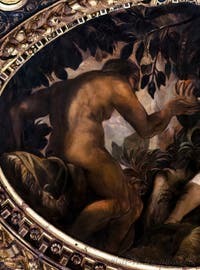
Original Sin The shadow of guilty conscience invades the body of Adam as the action unfolds before our eyes.
Now they know that through the knowledge of good and evil, they will be autonomous and free, but fully responsible for their actions.
The first sin is responsible for the fall into a hostile world where the carefree innocence has disappeared: from that moment on man is the sole judge, but he will have to bear all the consequences of his choices.
Thus begins the history of mankind, where the righteous will be separated from the sinners who choose evil and who will be punished!
This work would appear to be an introduction to the decorative programme of San Rocco, illustrating the quest for the salvation of mankind.
The Tintoretto “The Sacrifice of Isaac”
Oil on canvas (2.65m x 3.70m) 1577-1578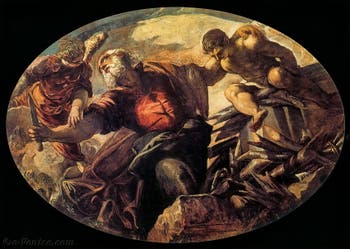
The Tintoretto, The Sacrifice of Isaac
“Then Abraham stretched out his hand and took the knife to immolate his son...”
Genesis 22, verse 10
This is the awful moment when Abraham is about to kill his son Isaac to prove his faith in God:
Abraham dominates the scene with all his powerful stature, having placed his left hand on the shoulders of his son whom he is holding folded in half on the pile of wood for the holocaust, when the Angel intervenes just in time to prevent the gesture of his arm holding a knife.
Such was the terrible test of faith for a man who found himself in the most absurd and cruel situation imaginable:
God was asking him to sacrifice the person he loved most in the world, his son whom God had given him!
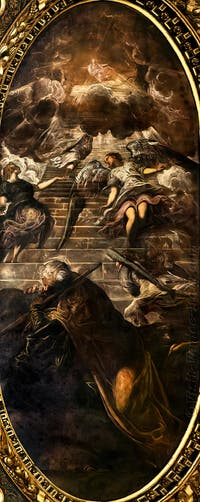
The Ladder or Jacob's Vision The Tintoretto does seem to have made the connection between Abraham, who was prepared to sacrifice his son for the love of God, and Christ, who sacrificed himself for the love of mankind.
The Tintoretto “The Ladder or The Vision of Jacob”
Oil on Canvas (660 x 265 cm) 1577-1578Jacob is resting after a long day's walk:
Genesis chapter 28.
“Taking one of the stones of the place, he made it his bedside and lay down in that place.
He had a dream: behold, a ladder was set up on the ground and its top touched heaven, and behold, angels were ascending and descending.
And behold, Yahweh stood by him.”
Jacob was asleep, his pilgrim's staff in his hand and one cheek resting on the rock he had found to rest on.
Behind this man sleeping quite uncomfortably in this nameless place, the door to heaven opens: an immense staircase occupied by celestial beings climbs endlessly into the light, up to the distant, tiny silhouette of Yahweh.
The Tintoretto presents us with the irruption of the supernatural into the banal.
By forcing the perspective, he gives us a vision of the infinity that separates man from the omnipresent God who watches over him and always offers him a way to reach him.
History Art Scuola | Rivalries | Crucifixion | Pilate Ecce Homo Calvary | Official Painter | Snake | Moses Manna | Sin Isaac Jacob | Adoration Temptation Breads | Probatic Pool Last Supper | Olive Garden Resurrection | Pianta | Annunciation Adoration Flight | Innocents Circumcision
San Rocco History Art | Location | Opening Hours Tickets | Authorizations
Museums Doge's Palace | Guggenheim | Correr | Pesaro | Rezzonico | Murano | Accademia | Oriental | Ca d'Oro | Archeological | Querini | Bovolo | Pisani | Fortuny | Rocco | Lace | Marciana | Grassi | Dogana
Back to Top of Page

